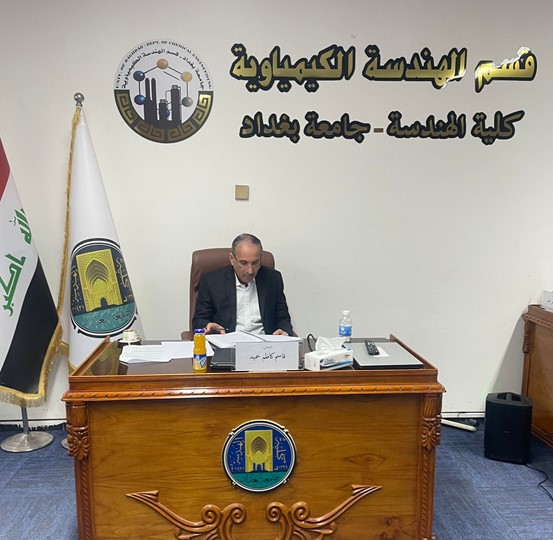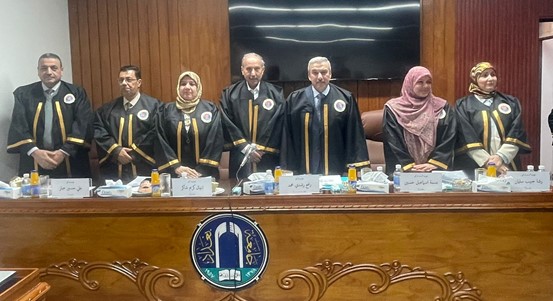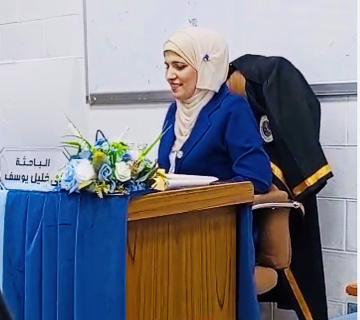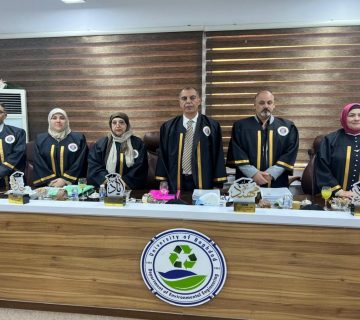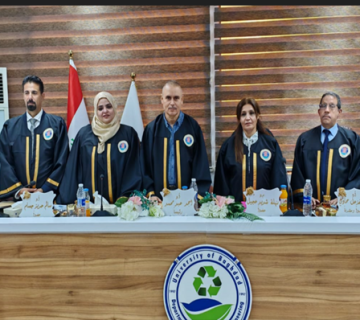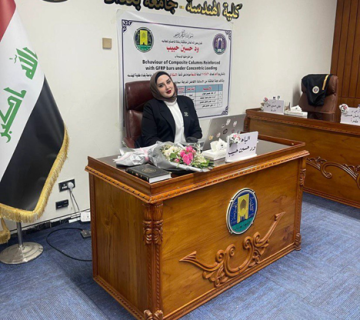The Chemical Engineering Department at the College of Engineering, University of Baghdad, held a Ph.D. dissertation examination titled:
“ Treatment of Petroleum Refinery Wastewater by an Integrated Electrocoagulation Photocatalytic Oxidation Using Green Synthesized ZnO Nanoparticles“
By the student Kassim Kadhim Hameed and supervised by Prof. Dr. Wadood Taher Mohammed. The examination committee consisted of Prof. Dr. Rafie Rushdy Mohammed as Chairman and the membership of Prof. Dr. Ibtehal K. Shakir, Prof. Dr. Ali H. Abbar. Asst. Prof. Dr. Rasha Habeeb Salman and Asst. Prof. Dr. Basma Ismael Waisi. After conducting the public discussion and listening to the student’s defense, the dissertation was accepted. The dissertation was summarized as follows:
This research represents the process of removing organic pollutants from a wastewater sample taken from the Najaf refinery with an organic content of 1278 parts per million (COD) by combining electrocoagulation and photocatalytic oxidation methods. In the first step, the research involved preparing nano zinc oxide using the green method as a photocatalyst.
The use of medicinal plants in preparing metal oxide nanoparticles represents an environmentally friendly alternative to traditional chemicals that may be harmful to humans and the environment. This study aims to use the leaf extract of Nasturtium, a common medicinal plant found in home gardens, to prepare zinc oxide nanoparticles through a simple and eco-friendly approach. The current study involved preparing three zinc oxide nano models through a reaction between aqueous zinc acetate and varying amounts of Nasturtium leaf extract. The first model of zinc oxide nanoparticles was obtained and named 1:1 ZnO (50 ml solution of aqueous zinc acetate: 50 ml solution of leaf extract). Finally, two other zinc oxide models were prepared using the same method mentioned above under the names 1:2 ZnO and 1:4 ZnO, using extract volumes of 100 ml and 200 ml, respectively.
The characterization of these nanoparticles was conducted using techniques such as X-ray diffraction, Fourier-transform infrared spectroscopy (FTIR), scanning electron microscopy (SEM), energy-dispersive X-ray spectroscopy (EDS), Brunauer-Emmett-Teller (BET) analysis, ultraviolet (UV) spectroscopy, and zeta potential analysis. The results revealed that these nanoparticles are pure and have an average size of 23 nanometers when synthesized with a 1:1 ratio of zinc oxide to leaf extract. Moreover, they exhibit high stability, a hexagonal crystal structure, spherical morphology, a surface area of approximately 48.35 cm²/g, and a zeta potential of around -19 mV. The photocatalytic activity of the zinc oxide nanoparticles synthesized at a 1:1 ratio was evaluated by examining the degradation of methylene blue under UV exposure. An 82% removal efficiency was achieved within 90 minutes, while commercial zinc oxide achieved a removal efficiency of about 72% for the same duration. The results demonstrated that biologically synthesized zinc oxide nanoparticles exhibit unique photocatalytic potential.
In the second step: The current study enhanced and improved the effectiveness of the photocatalytic method in treating various pollutants, including cyclic compounds with weak light absorption properties that hinder the penetration of ultraviolet rays to the photocatalyst fixed on a concrete surface. This improvement was achieved through the implementation of a new photoreactor design, used for the first time to treat pollutants. The innovative approach involved introducing pollutants into the reactor in a 3 mm thick flow layer, facilitating the passage of ultraviolet rays and easy access to the catalyst surface. This resulted in increased treatment efficiency and reduced treatment time compared to previous techniques.
The removal efficiency for pollutants (COD) was 72% after 120 minutes when using the electrocoagulation process under conditions of 15 mA/cm², pH 7, and a flow rate of 0.5 L/min. Regarding the photocatalytic process, the COD removal efficiency was 76% after 120 minutes under conditions of 80 g/m² ZnO concentration, pH 7, 65 W radiation power, and a flow rate of 0.5 L/min. Several sequential and simultaneous combined systems were tested. The results confirmed that the simultaneous combined system (photocatalysis- electrocoagulation) operating at 30 minutes was the best, capable of achieving 82% pollutant removal (COD) under conditions of 15 mA/cm², pH 7, flow rate of 0.5 L/min, ZnO concentration of 80 g/m², and 65 W power. Moreover, other notable features of the simultaneous combined (photocatalysis-electrocoagulation) system included a shorter operating time and a low anode electrode dissolution rate (0.2 gram), making it the most economical process with an energy consumption of 28.44 kWh/kg COD.
Accordingly, the research concluded with a set of recommendations, including:
* Studying the factors affecting the shape and size of nanoparticles, such as pH and mixing speed of reactive materials.
* Integrating modern technology with the green method for preparing nanoparticles to obtain high purity.
* Focusing on studying the stability of nanoparticles for the longest possible period.
* Using technologies such as plasma and evaporation to coat the reactor floor with nanoparticles instead of fixing them with concrete.
* Studying the removal efficiency increase of pollutants by improving the removal efficiency of hydrogen produced from the electrocoagulation process.
* Combining advanced oxidation technology, such as ozone, with Fenton oxidation to remove complex hydrocarbon pollutants.
After the scientific discussion by the members of the examination committee, listening to the researcher’s defense, and evaluating the dissertation, the researcher was awarded a doctorate degree in Chemical Engineering with distinction.

